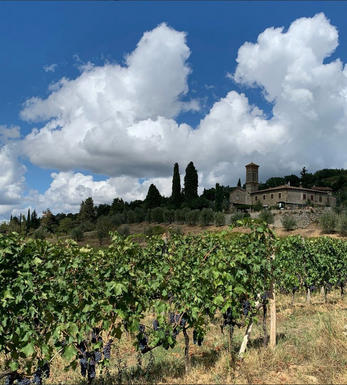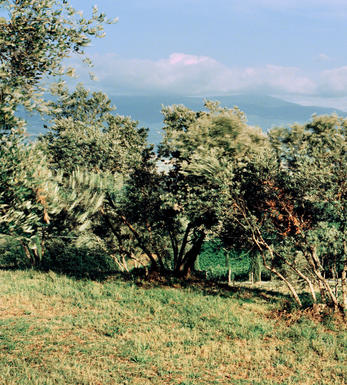
About this WINE

Querciabella
The story of Querciabella, or its charming translation ‘beautiful oak’, started in 1974 when oenophile and businessman, Giuseppe (Pepito) Castiglioni brought the estate. The Castiglione family has always pushed boundaries, by planting non-indigenous grape varieties and converting their vineyards to Biodynamic farming.
Since 1981, Camartina has been the estate’s leading Super-Tuscan. Camartina is part of a revolutionary but highly select group of wines, which firmly elevated Italian wine to the world stage. The estate was unhappy with the mediocrity of the Tuscan region, which, in turn, sparked creativity and innovation amongst the best wineries. Querciabella took a risk when producing Camartina, as they eschewed the strict rules of the Chianti Classico region.
Originally, the blend of Camartina favoured Sangiovese but over the years, Cabernet Sauvignon has usurped the traditional, Tuscan grape variety. This is due to the Bordeaux variety acclimatising to Ruffoli’s sandstone slopes. French Oak is the material of choice for the fermentation vessels, creating integrated tannins in the wine. The Sangiovese and Cabernet Sauvignon wines are matured separately for 18 months in French Oak barrels. The leading barrels are selected to make up the final blend.

Tuscany
Responsible for only 6 percent of Italy's total wine production in 2006 (half that of the Veneto) Tuscany may not be a heavyweight in terms of quantity, but as the home of two of the country's most famous fine wines - Chianti and Brunello di Montalcino - it certainly holds its own in terms of quality.
Tuscany is Italy's most ancient wine region, dating back to the 8th century BC when the Etruscans developed the area in parallel with the Greeks, before ceding to the Romans. Along with building roads and sewers, they developed the region's viticultural potential, using wood for winemaking rather than amphorae, and passing their expertise onto their French neighbours. With the demise of Rome in the 5th century AD, the Longobards established Lucca as the capital of what was then known as Tuscia. Florence and Siena became banking and trading hubs during the Middle Ages, with Chianti – then a white wine – first documented in the 14th century.Tuscany passed from the Medicis to the Habsburgs as part of the Holy Roman Empire, and then onto the Austrian Empire before becoming part of a reunified Italy in 1861. The quality of Chianti was first recognised by the Grand Duke of Tuscany, Cosimo III, who classified its finest areas in 1716.
Located in the west-central part of the country with the Tyrrhenian Sea lapping its coastline, Tuscany's climate ranges from Mediterranean on the coast to continental deep in the Apennines. More than two thirds of the province is covered with hills, an important terroir factor in the production of fine Tuscan wine. The finest such areas are Chianti Classico, Chianti Rufina, Brunello di Montalcino, Vino Nobile di Montepulciano, Morellino di Scansano and Bolgheri. Sangiovese (in its various clones) is the black grape of choice.
Recommended producers: Valgiano, Caiarossa, Villa Calcinaia, Bibbiano, Badia a Coltibuono, La Serena, Scopetone, Lisini, Sesti, San Giuseppe, Cerbaiona.

Merlot
The most widely planted grape in Bordeaux and a grape that has been on a relentless expansion drive throughout the world in the last decade. Merlot is adaptable to most soils and is relatively simple to cultivate. It is a vigorous naturally high yielding grape that requires savage pruning - over-cropped Merlot-based wines are dilute and bland. It is also vital to pick at optimum ripeness as Merlot can quickly lose its varietal characteristics if harvested overripe.
In St.Emilion and Pomerol it withstands the moist clay rich soils far better than Cabernet grapes, and at it best produces opulently rich, plummy clarets with succulent fruitcake-like nuances. Le Pin, Pétrus and Clinet are examples of hedonistically rich Merlot wines at their very best. It also plays a key supporting role in filling out the middle palate of the Cabernet-dominated wines of the Médoc and Graves.
Merlot is now grown in virtually all wine growing countries and is particularly successful in California, Chile and Northern Italy.



Buying options
Add to wishlist
wine at a glance
Delivery and quality guarantee